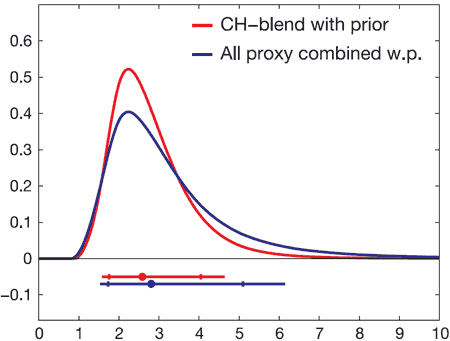Climate sensitivity (the amount the planet's average surface temperature will warm given a certain energy imbalance, including feedbacks) is the key to global warming skepticism. The amount of warming at the Earth's surface depends on two factors — the size of the energy imbalance, and the climate sensitivity to that energy. However, the first factor (the energy imbalance caused by the increase in greenhouse gases) is a well-measured and well-known quantity.
Therefore, the only way to argue that humans aren’t driving global temperatures now, and temperature change over the next century won’t be potentially catastrophic in a business-as-usual scenario, is if climate sensitivity is low. "Skeptic" climate scientists like Lindzen, Spencer, and Christy realize this, and it's why their arguments consistently center around the argument "climate sensitivity is low".
The heat trapped by the increased atmospheric CO2 has to go somewhere, and the only way it's not causing and will not cause significant global warming and climate change in the future is if it's suppressed by cooling effects from negative feedbacks. If this were the case, climate sensitivity would be low. And this is indeed a key argument made in the NIPCC report:
"Scientific research suggests the model-derived temperature sensitivity of the earth accepted by the IPCC is too large. Corrected feedbacks in the climate system could reduce climate sensitivity to values that are an order of magnitude smaller."
The NIPCC report is claiming that the IPCC sensitivity range is too high by a factor of 10, but the Idso Prudent Path document, by claiming that the MWP was as hot or hotter than today, is arguing that the IPCC sensitivity range is too low.
Hot MWP Means High Sensitivity
As John Cook has previously discussed, arguing for large swings in natural temperature variation such as a particularly hot MWP is akin to arguing for high climate sensitivity. Several scientific studies have examined the radiative forcings and temperature changes over the past millennium, such as Hegerl et al 2006, as shown in Figure 2:

Figure 2: Climate sensitivity from palaeoreconstructions going back 750 years, combined with climate sensitivity calculated from instrumental records. The horizontal bars represent the 5 to 95% range, indicating a climate sensitivity range of 1.5 to 6.2°C for a doubling of atmospheric CO2 (Hegerl et al 2006). When you combine the temperature record over the past millennium with climate forcings, you get a most likely climate sensitivity value close to 3°C, consistent with the IPCC climate sensitivity range of 2°C to 4.5°C. So if the temperature swings were actually larger than in the reconstructions used by Hegerl and other studies on millennial climate sensitivity, it means the climate sensitivity is actually higher than the IPCC has concluded.
The two documents referenced in the "skeptic" letter to Congress blatantly contradict each other on this issue. The NIPCC report argues that the climate sensitivity is an order of magnitude lower than the IPCC range, while the Idso Prudent Path document indirectly argues that the sensitivity is higher than the IPCC range. On the most important issue for climate "skeptics" — climate sensitivity — the two documents cited in the "skeptic" letter to Congress contradict each other by a factor of ten.
The True Prudent Path
Ironically, although the two "skeptic" documents differ on the climate sensitivity parameter by an order of magnitude, both are wrong. There are many independent lines of evidence behind the IPCC climate sensitivity range, meaning that it's exceptionally unlikely that it's wrong by an order of magnitude, as the NIPCC report claims. And as discussed above, the evidence does not support the Idso claim that the MWP peak was as hot or hotter than today.
Thus the real "prudent path" involves proceeding under the assumption that the well-supported IPCC likely range of climate sensitivity (2 to 4.5°C with a most likely value of 3°C warming for a doubling of atmospheric CO2) is correct. In this scenario, we are heading towards extremely dangerous and potentially catastrophic warming and climate change this century in a business-as-usual scenario.
Thus the true prudent path involves taking immediate action to significantly reduce human CO2 emissions. If the "skeptics" want to convince us otherwise, they need to start by getting their story straight.
This post was written by Dana Nuccitelli (dana1981) and has been developed into the Intermediate rebuttal to "Ljungqvist broke the hockey stick"
 In this post we continue our Prudent Path Week theme, and the examination of the two documents the "skeptics" referenced in their recent letter to Congress — 'Carbon Dioxide and Earth's Future: Pursuing the Prudent Path' and the NIPCC report. Specifically, we examine a major contradiction between the two reports regarding a key factor in climate science - climate sensitivity.
In this post we continue our Prudent Path Week theme, and the examination of the two documents the "skeptics" referenced in their recent letter to Congress — 'Carbon Dioxide and Earth's Future: Pursuing the Prudent Path' and the NIPCC report. Specifically, we examine a major contradiction between the two reports regarding a key factor in climate science - climate sensitivity. 


